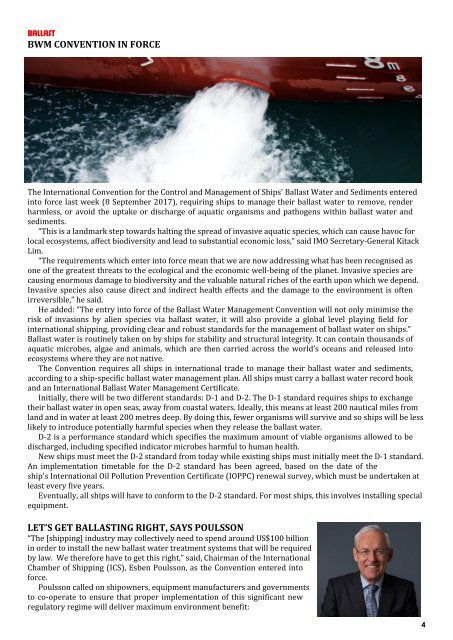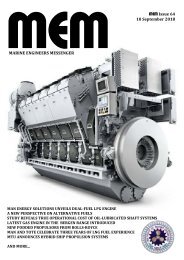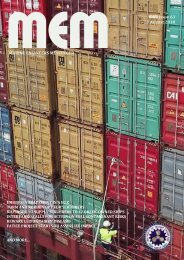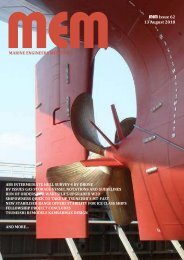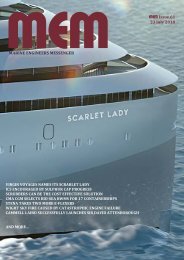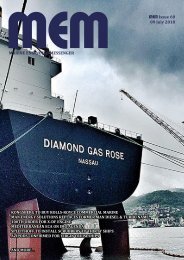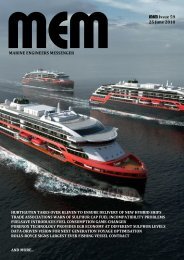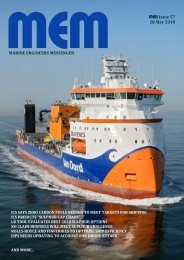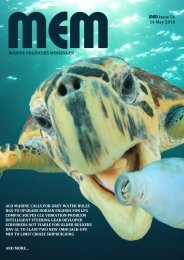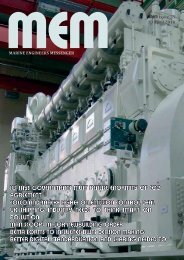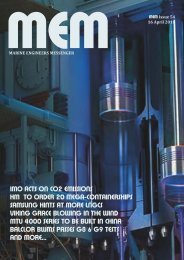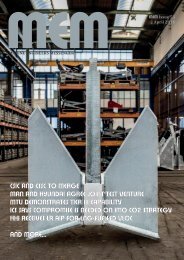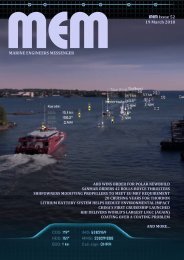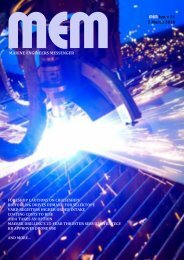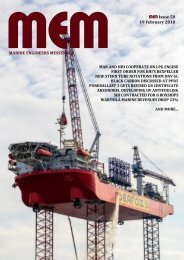MEM39
Marine Engineers Messenger, Volume 2, Issue 39
Marine Engineers Messenger, Volume 2, Issue 39
You also want an ePaper? Increase the reach of your titles
YUMPU automatically turns print PDFs into web optimized ePapers that Google loves.
BALLAST<br />
BWM CONVENTION IN FORCE<br />
The International Convention for the Control and Management of Ships' Ballast Water and Sediments entered<br />
into force last week (8 September 2017), requiring ships to manage their ballast water to remove, render<br />
harmless, or avoid the uptake or discharge of aquatic organisms and pathogens within ballast water and<br />
sediments.<br />
“This is a landmark step towards halting the spread of invasive aquatic species, which can cause havoc for<br />
local ecosystems, affect biodiversity and lead to substantial economic loss,” said IMO Secretary-General Kitack<br />
Lim.<br />
“The requirements which enter into force mean that we are now addressing what has been recognised as<br />
one of the greatest threats to the ecological and the economic well-being of the planet. Invasive species are<br />
causing enormous damage to biodiversity and the valuable natural riches of the earth upon which we depend.<br />
Invasive species also cause direct and indirect health effects and the damage to the environment is often<br />
irreversible,” he said.<br />
He added: “The entry into force of the Ballast Water Management Convention will not only minimise the<br />
risk of invasions by alien species via ballast water, it will also provide a global level playing field for<br />
international shipping, providing clear and robust standards for the management of ballast water on ships.”<br />
Ballast water is routinely taken on by ships for stability and structural integrity. It can contain thousands of<br />
aquatic microbes, algae and animals, which are then carried across the world’s oceans and released into<br />
ecosystems where they are not native.<br />
The Convention requires all ships in international trade to manage their ballast water and sediments,<br />
according to a ship-specific ballast water management plan. All ships must carry a ballast water record book<br />
and an International Ballast Water Management Certificate.<br />
Initially, there will be two different standards: D-1 and D-2. The D-1 standard requires ships to exchange<br />
their ballast water in open seas, away from coastal waters. Ideally, this means at least 200 nautical miles from<br />
land and in water at least 200 metres deep. By doing this, fewer organisms will survive and so ships will be less<br />
likely to introduce potentially harmful species when they release the ballast water.<br />
D-2 is a performance standard which specifies the maximum amount of viable organisms allowed to be<br />
discharged, including specified indicator microbes harmful to human health.<br />
New ships must meet the D-2 standard from today while existing ships must initially meet the D-1 standard.<br />
An implementation timetable for the D-2 standard has been agreed, based on the date of the<br />
ship's International Oil Pollution Prevention Certificate (IOPPC) renewal survey, which must be undertaken at<br />
least every five years.<br />
Eventually, all ships will have to conform to the D-2 standard. For most ships, this involves installing special<br />
equipment.<br />
LET’S GET BALLASTING RIGHT, SAYS POULSSON<br />
“The [shipping] industry may collectively need to spend around US$100 billion<br />
in order to install the new ballast water treatment systems that will be required<br />
by law. We therefore have to get this right,” said, Chairman of the International<br />
Chamber of Shipping (ICS), Esben Poulsson, as the Convention entered into<br />
force.<br />
Poulsson called on shipowners, equipment manufacturers and governments<br />
to co-operate to ensure that proper implementation of this significant new<br />
regulatory regime will deliver maximum environment benefit:<br />
4


